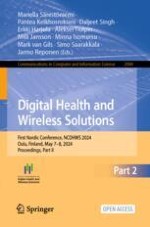Open Access 2024 | Open Access | Book

Digital Health and Wireless Solutions
First Nordic Conference, NCDHWS 2024, Oulu, Finland, May 7–8, 2024, Proceedings, Part II
Editors: Mariella Särestöniemi, Pantea Keikhosrokiani, Daljeet Singh, Erkki Harjula, Aleksei Tiulpin, Miia Jansson, Minna Isomursu, Mark van Gils, Simo Saarakkala, Jarmo Reponen
Publisher: Springer Nature Switzerland
Book Series : Communications in Computer and Information Science